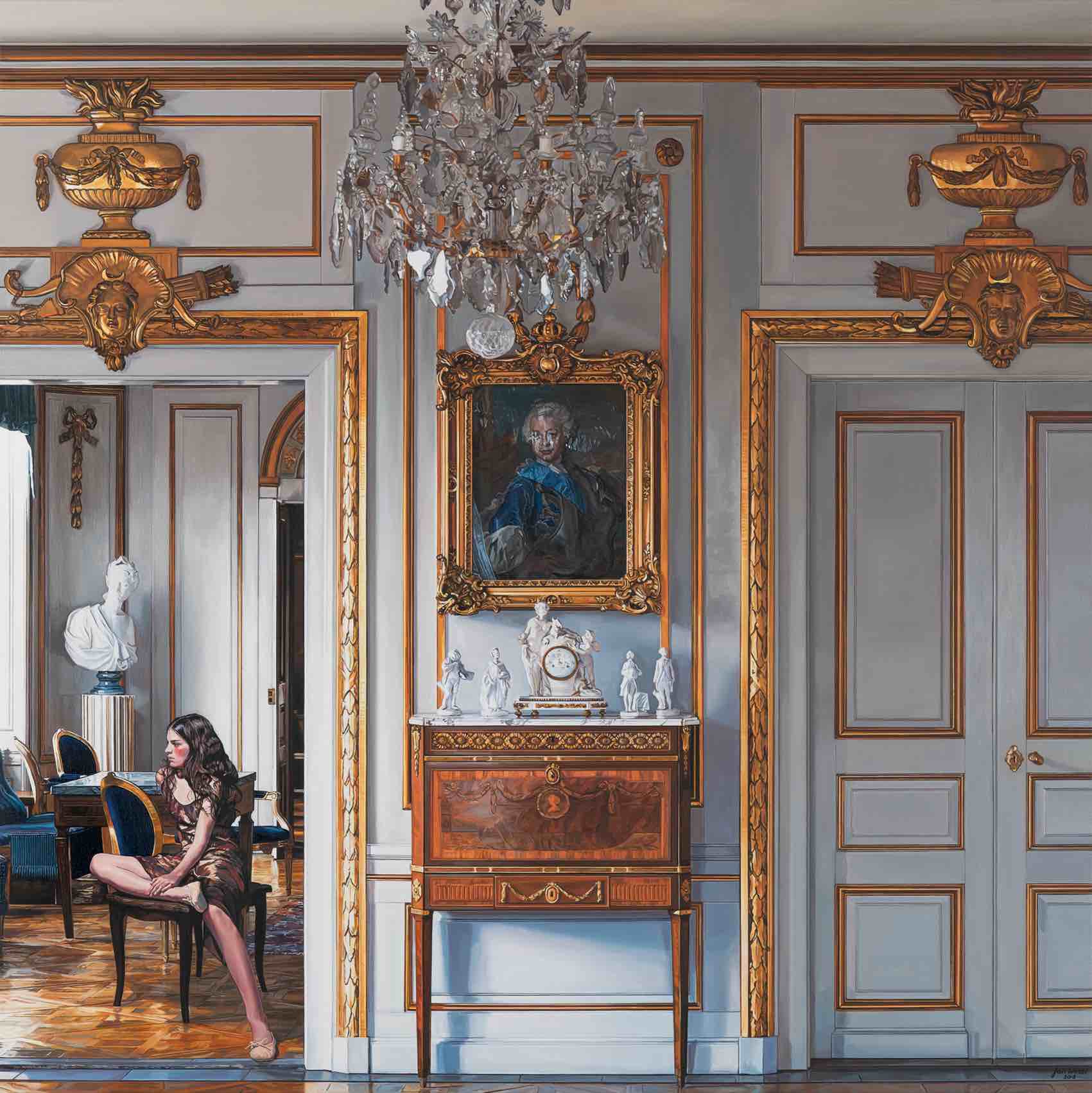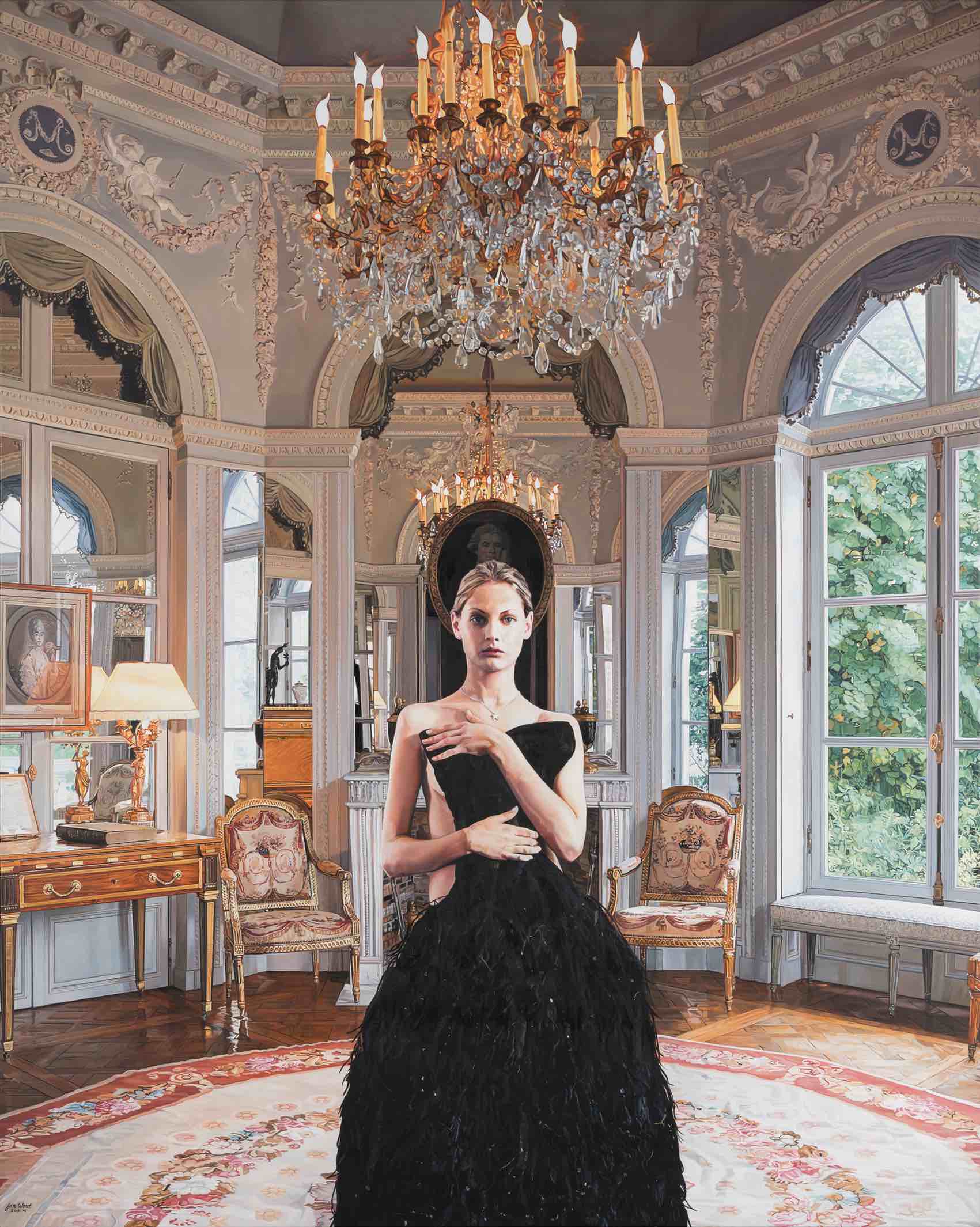ABOUT STOP PRESS
Stop Press is ISBN Magazine’s guide to happenings in Hong Kong. From art to auctions and from food to fashion, to entertainment, cinema, sport, wine and design, scroll through the best of the city's dynamic cultural offerings. And if your event merits mention in our little book of lifestyle chic, write to us at stoppress@isbn-magazine.com
superior interiors
![]() To walk into Ben Brown Fine Arts in Hong Kong and observe Dutch artist Jan Worst's Interiors is an almighty visual deception. On first sight they appear to be photographs, on which the artist has played some trick of light, and we wonder what elevates them to the realm of 'art'. But closer inspection reveals the creative 'wow' of the work; these are paintings, right down to the last methodical and meticulous detail of the letters on every leather-bound book spine on shelves, gilded door knobs, alabaster statues and folded napkins and wine bottles on dining tables. The photographic realism of these canvases is stunning - almost unsettling - to behold.
To walk into Ben Brown Fine Arts in Hong Kong and observe Dutch artist Jan Worst's Interiors is an almighty visual deception. On first sight they appear to be photographs, on which the artist has played some trick of light, and we wonder what elevates them to the realm of 'art'. But closer inspection reveals the creative 'wow' of the work; these are paintings, right down to the last methodical and meticulous detail of the letters on every leather-bound book spine on shelves, gilded door knobs, alabaster statues and folded napkins and wine bottles on dining tables. The photographic realism of these canvases is stunning - almost unsettling - to behold.
Everything's so stately, a sort of Architectural Digest meets Grace Coddington mood board for Vogue, and rendered in a style reminiscent of photographer Robert Polidori's visual diary of the restoration of The Palace of Versailles in France, yet redolent of the Dutch Golden Age in the 17th century and painters such as Jan Vermeer.
Worst portrays lavish interiors of seemingly historic, presumably European, grand homes. Incongruously confined within each dimly lit interior is a young woman whose likeness is directly inspired by contemporary fashion magazines - scantily clad, gazing into the distance, languorously perched upon the formal furniture. It makes us think of the current Guccification of the aesthetic, nurtured by designer Alessandro Michele, the Gucci-sponsored exhibition at England's Chatsworth House, and the adverts the Italian luxury house plans to shoot within Chatsworth and the grounds of the historic house for the next three years. Or did it work the other way. Did Worst make Michele think of such mise-en-scene for the Italian fashion house?

But that's just the half of it. Adding to the tension and sense of voyeurism in these paintings, there is often a seemingly aristocratic small child or older gentleman lurking in a corner or shadow, the female figure entirely unaware of or indifferent to their presence. Or in the case of The Lecture, which has a Hockney-esque staging to it, we sense a connection between 'characters' with a past and present. Belgian artist Michael Borremans does a similar thing with a different palette. He depicts contemporary characters in somewhat ludic outfits and settings, but rather than place them in historic settings, he paints in the historic style of Velasquez or Goya to destabilise the viewer's expectations and understanding.
It's suspense. A plot device as old as storytelling. Worst has maintained a very deliberate ambiguity throughout his career. Is he glorifying or critiquing the wealth and privilege of his subjects and their sumptuous dwellings? Why are these seductive women lurking in staid and airless rooms and what is their relationship to the children and men in the paintings? Worst's paintings challenge viewers with these questions while at the same time simply allow us to savour their beauty, opulence and richness of detail, all perhaps a meditation on human desire.

A young, nude model clinging to a black gown (left) punctuates the centre of a stately room in Divine Details (2013-2014), as though she were cut from a fashion magazine or film still and collaged into the scene. (Worst often uses the same figure in identical poses in other canvases) Worst employs playful contrasts in the painting by depicting an antiquated portrait of a white-wigged sitter hanging directly above the youthful model's head, the ornate candelabra on the wall becoming a mock crown. His dexterous renderings of mirrors and reflections demonstrate his painting virtuosity and reverence for old masters such as Johannes Vermeer. The irresistible beauty of both the female figure and the perfectly appointed room with its rose-patterned carpet and flickering candles subtly belies the unsettling and enigmatic nature of the scene. Great to gaze at, gawp at, and gram, (that's Instagram), for those so inclined.
Ben Brown Fine Arts, Hong Kong, 303 Pedder Building, 12 Pedder Street, Central, Hong Kong. Opening times: Mon-Sat 11am-7pm
Images from top:
Objects and Icons, 2017, oil on canvas, 120cm x 120cm.
A Proper Distance, 2016, oil on canvas, 150cm x 150cm
Divine Details, 2013-2014, oil on canvas, 250cm x 200cm
© 2016 BenBrownFineArts
superior interiors
![]() To walk into Ben Brown Fine Arts in Hong Kong and observe Dutch artist Jan Worst's Interiors is an almighty visual deception. On first sight they appear to be photographs, on which the artist has played some trick of light, and we wonder what elevates them to the realm of 'art'. But closer inspection reveals the creative 'wow' of the work; these are paintings, right down to the last methodical and meticulous detail of the letters on every leather-bound book spine on shelves, gilded door knobs, alabaster statues and folded napkins and wine bottles on dining tables. The photographic realism of these canvases is stunning - almost unsettling - to behold.
To walk into Ben Brown Fine Arts in Hong Kong and observe Dutch artist Jan Worst's Interiors is an almighty visual deception. On first sight they appear to be photographs, on which the artist has played some trick of light, and we wonder what elevates them to the realm of 'art'. But closer inspection reveals the creative 'wow' of the work; these are paintings, right down to the last methodical and meticulous detail of the letters on every leather-bound book spine on shelves, gilded door knobs, alabaster statues and folded napkins and wine bottles on dining tables. The photographic realism of these canvases is stunning - almost unsettling - to behold.
Everything's so stately, a sort of Architectural Digest meets Grace Coddington mood board for Vogue, and rendered in a style reminiscent of photographer Robert Polidori's visual diary of the restoration of The Palace of Versailles in France, yet redolent of the Dutch Golden Age in the 17th century and painters such as Jan Vermeer.
Worst portrays lavish interiors of seemingly historic, presumably European, grand homes. Incongruously confined within each dimly lit interior is a young woman whose likeness is directly inspired by contemporary fashion magazines - scantily clad, gazing into the distance, languorously perched upon the formal furniture. It makes us think of the current Guccification of the aesthetic, nurtured by designer Alessandro Michele, the Gucci-sponsored exhibition at England's Chatsworth House, and the adverts the Italian luxury house plans to shoot within Chatsworth and the grounds of the historic house for the next three years. Or did it work the other way. Did Worst make Michele think of such mise-en-scene for the Italian fashion house?

But that's just the half of it. Adding to the tension and sense of voyeurism in these paintings, there is often a seemingly aristocratic small child or older gentleman lurking in a corner or shadow, the female figure entirely unaware of or indifferent to their presence. Or in the case of The Lecture, which has a Hockney-esque staging to it, we sense a connection between 'characters' with a past and present. Belgian artist Michael Borremans does a similar thing with a different palette. He depicts contemporary characters in somewhat ludic outfits and settings, but rather than place them in historic settings, he paints in the historic style of Velasquez or Goya to destabilise the viewer's expectations and understanding.
It's suspense. A plot device as old as storytelling. Worst has maintained a very deliberate ambiguity throughout his career. Is he glorifying or critiquing the wealth and privilege of his subjects and their sumptuous dwellings? Why are these seductive women lurking in staid and airless rooms and what is their relationship to the children and men in the paintings? Worst's paintings challenge viewers with these questions while at the same time simply allow us to savour their beauty, opulence and richness of detail, all perhaps a meditation on human desire.

A young, nude model clinging to a black gown (left) punctuates the centre of a stately room in Divine Details (2013-2014), as though she were cut from a fashion magazine or film still and collaged into the scene. (Worst often uses the same figure in identical poses in other canvases) Worst employs playful contrasts in the painting by depicting an antiquated portrait of a white-wigged sitter hanging directly above the youthful model's head, the ornate candelabra on the wall becoming a mock crown. His dexterous renderings of mirrors and reflections demonstrate his painting virtuosity and reverence for old masters such as Johannes Vermeer. The irresistible beauty of both the female figure and the perfectly appointed room with its rose-patterned carpet and flickering candles subtly belies the unsettling and enigmatic nature of the scene. Great to gaze at, gawp at, and gram, (that's Instagram), for those so inclined.
Ben Brown Fine Arts, Hong Kong, 303 Pedder Building, 12 Pedder Street, Central, Hong Kong. Opening times: Mon-Sat 11am-7pm
Images from top:
Objects and Icons, 2017, oil on canvas, 120cm x 120cm.
A Proper Distance, 2016, oil on canvas, 150cm x 150cm
Divine Details, 2013-2014, oil on canvas, 250cm x 200cm
© 2016 BenBrownFineArts
